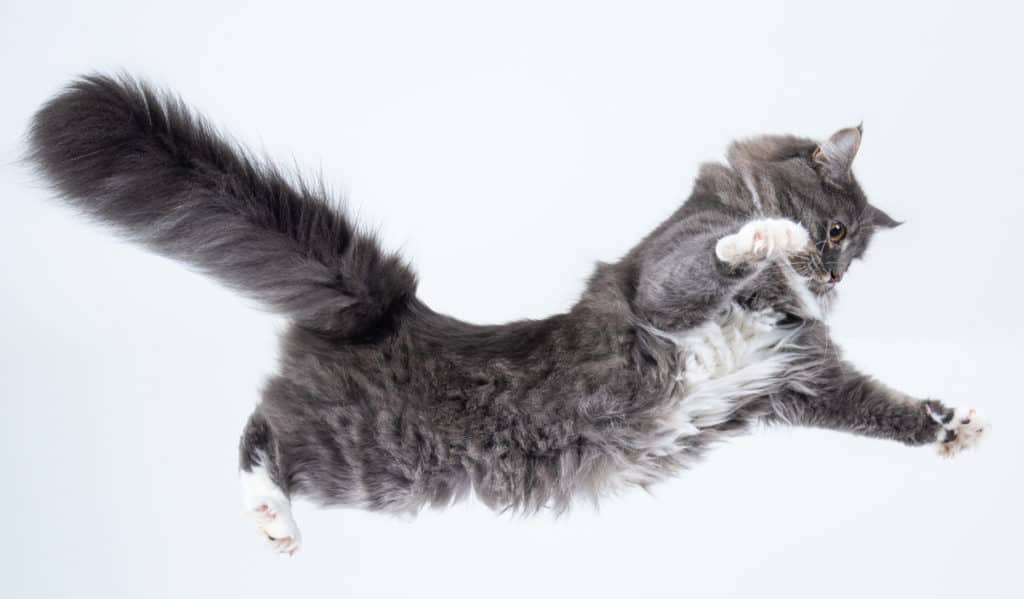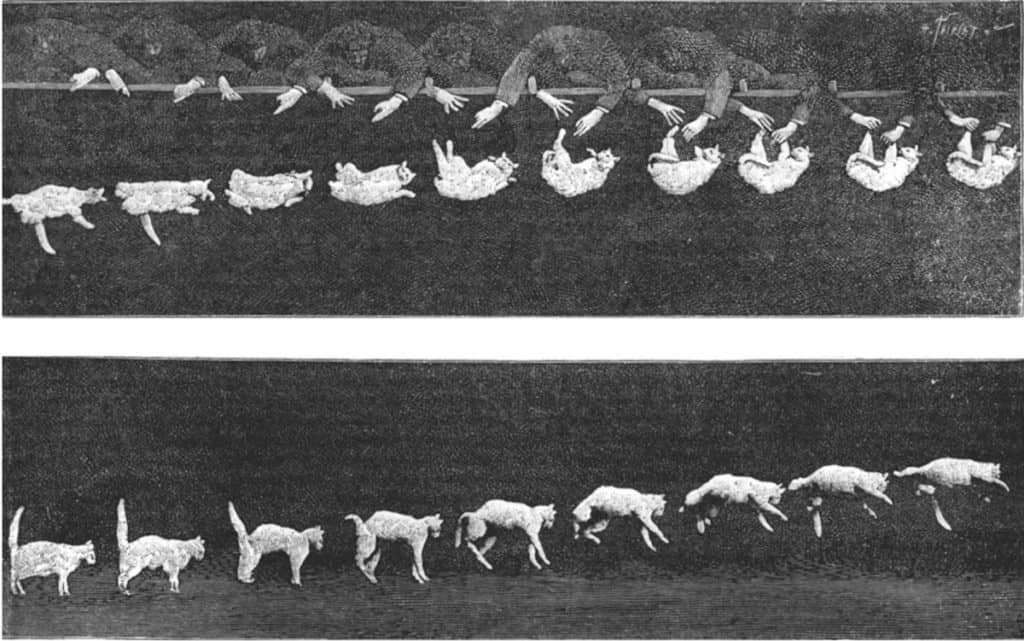Cats are amazing animals. Their grace, agility, and stealth are only a few of their unique qualities. One of their most amazing capabilities is their ability to right themselves when falling. They do this by arching their back, flexing their legs, and spreading their paws.
Cats are not alone, other animals such as frogs, lizards, and cheetahs, show similar properties. This article will look at how cats land on their feet after falling and what is the physiology that helps cats.
Cats are flexible
Cats are famous for their unique flexibility and ability to land on their feet. Cats have thirty vertebrae in the backbone and a free-floating collarbone for better flexibility and nimbleness.
When a fall happens, the cat’s spine arches, their legs stretch together with the belly towards the head-across-chest position and they cover themselves while cartwheeling with forepaws to face downwards to land on their feet.

They also have extremely flexible feet with soft paw pads that make great landing devices. Their low body weight to height ratio slows down the speed at terminal velocity making it easier for them to land safely as well.
Cats Have a Righting Reflex
Cats are famous for their righting reflex. Since they already have pretty great hearing and a sense of balance, it is believed that even if they fall from a high place their sensitive ears help them to turn in the air and maintain a balance to not suffer from any injury.
A cat’s balance and orientation are achieved by a complex organ known as the vestibular apparatus located in their ear. It enables them to quickly tell which direction they are facing in, and to rotate their head so they know where the rest of their body is in relation.
Cats Have Shock Absorber Legs
Cats have very long and prominent legs. Legs may look slender and dainty compared to the rest of their body, but they’re strong and powerful too! When they land after jumping, their angled legs act as shock absorbers so that when they land on a surface, most of the impact is absorbed by their muscles as opposed to being taken directly.
Do Cats Always Land On Their Feet?
According to studies, cats do not always land on their feet when they fall. This can be attributed to the fact that if a fall is shorter than 12 inches, a cat’s body may be traveling so fast as it falls that there isn’t a chance for it to try and react to save itself.
When the distance of an individual cat fall exceeds 12 inches, though, there’s enough time for the cat to properly react in order to right themselves or make sure at least one of their back paws ends up on the floor.
The First to Research the Falling Motion of a Cat
The first formal research on the falling motion of a cat was done by Étienne-Jules Marey, a French scientist. Marey had invented a photographic technique called chronophotography which allowed for the capture of 12 consecutive frames a second. Marey used this technique to study and document animal locomotion.

One of the animals Marey studied was the cat. Marey created a series of photographs from both the side and end view of a falling cat. The series which runs right to left shows Marey at the top of the photograph holding a cat by their legs before dropping the cat. Over 19 images, the cat can be seen twisting their body before extending their legs to safely fall to the ground.
Kane and Scher from Stanford University were able to model the mechanics by which a cat is able to right themself. The researchers published the results of their study in 1969 in a paper entitled, “A dynamical explanation of the falling cat phenomenon”.
Cats Can Injure Themselves Falling
While the ability of a cat to right themselves is an amazing ability, cats can still injure themselves when falling from great heights. Several studies have documented injuries and death of cats when falling from buildings.
Feline high-rise syndrome
The phenomenon of cats falling from windows and balconies of buildings in urban areas is known as “feline high-rise syndrome.” Fractures, thoracic trauma, and pulmonary contusions are all common injuries cats can sustain when falling from buildings.
If you live in a home with multiple stories, make sure that windows on upper floors, ledges and balconies are safe from becoming a falling hazard for your cats.
Read next: How High Can Cats Jump?
References
Kane, T. R., & Scher, M. P. (1969). A dynamical explanation of the falling cat phenomenon. International journal of solids and structures, 5(7), 663-670. https://doi.org/10.1016/0020-7683(69)90086-9
Photographs of a Tumbling Cat. (1894). Nature, 51(1308), 80–81. https://doi.org/10.1038/051080a0
Vnuk, D., Pirkić, B., Matičić, D., Radišić, B., Stejskal, M., Babić, T., … & Lemo, N. (2004). Feline high-rise syndrome: 119 cases (1998–2001). Journal of feline medicine and surgery, 6(5), 305-312. https://doi.org/10.1016/j.jfms.2003.07.001






